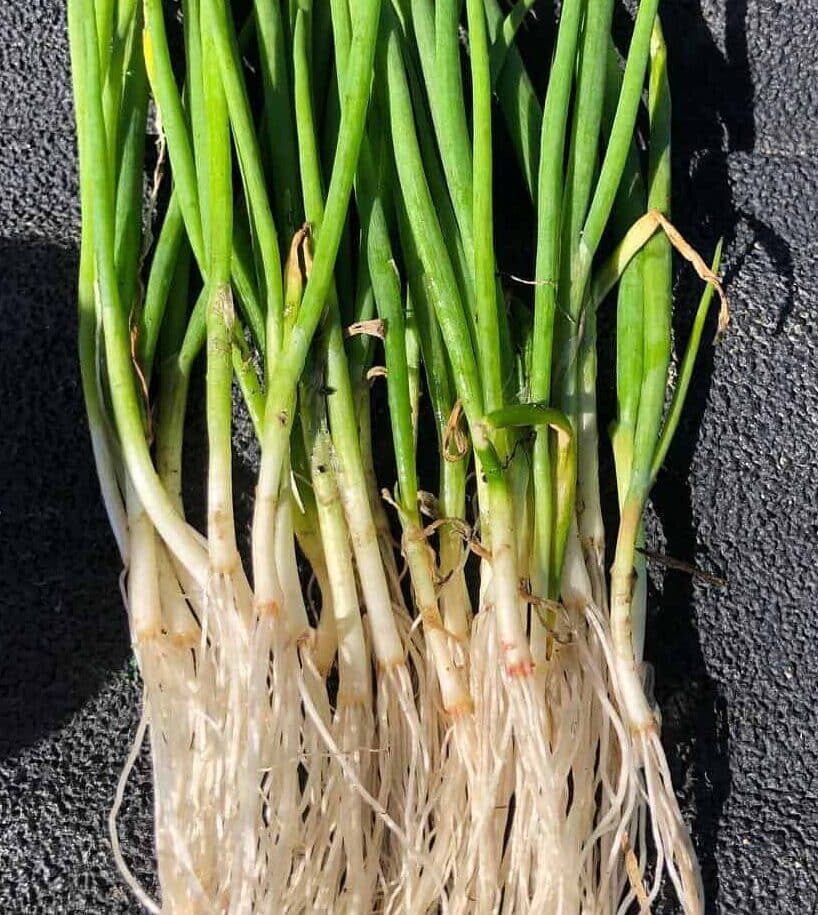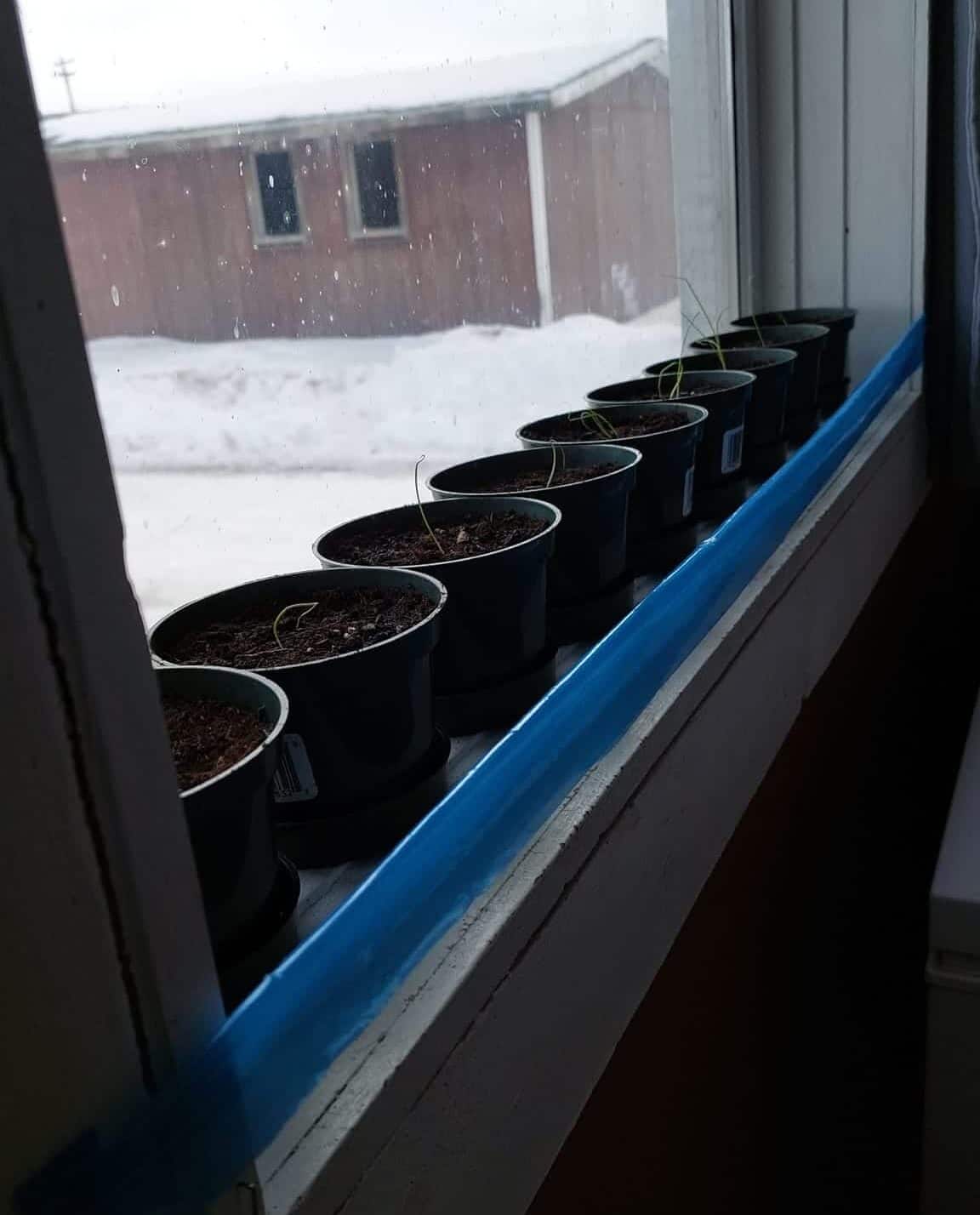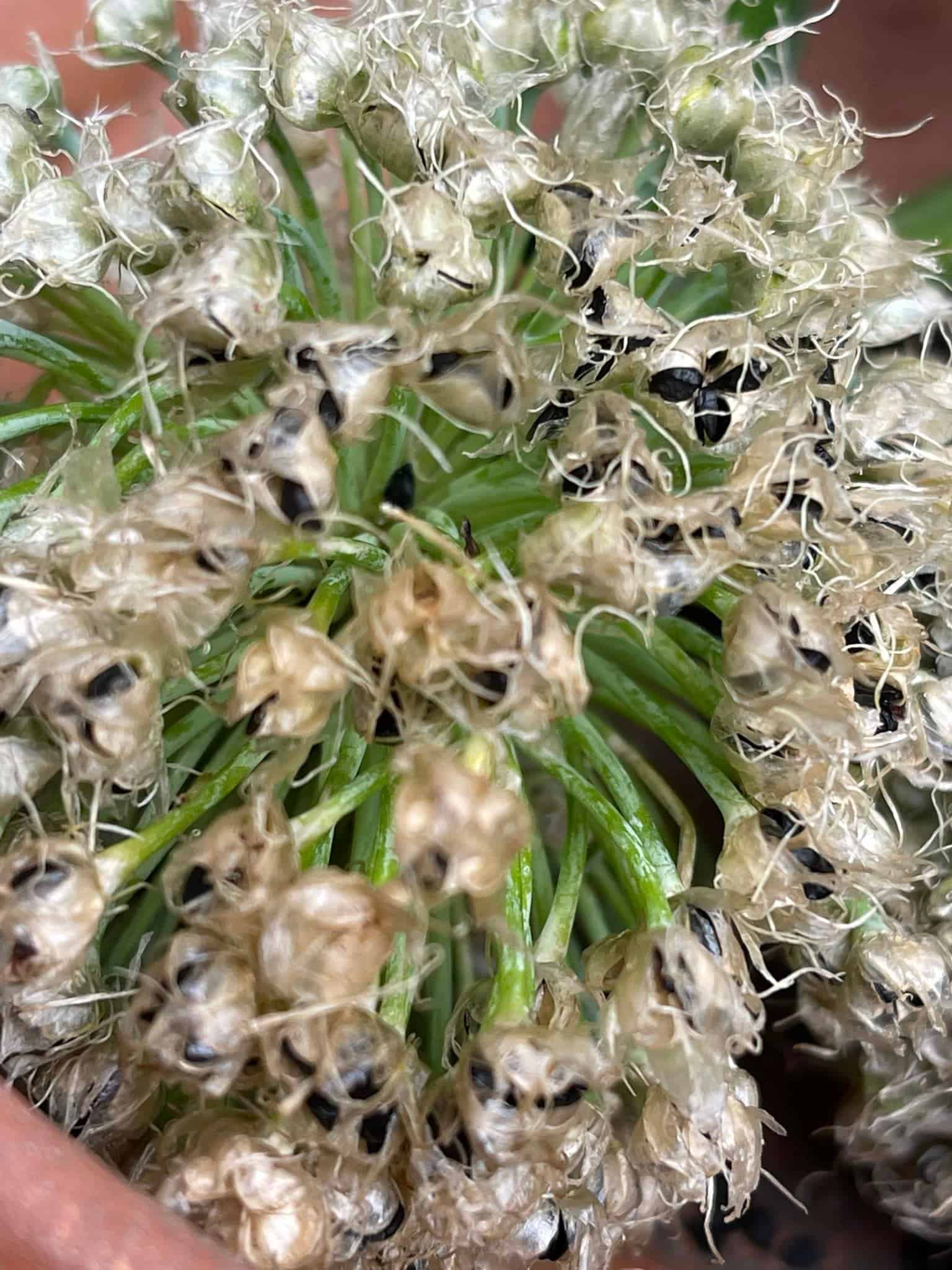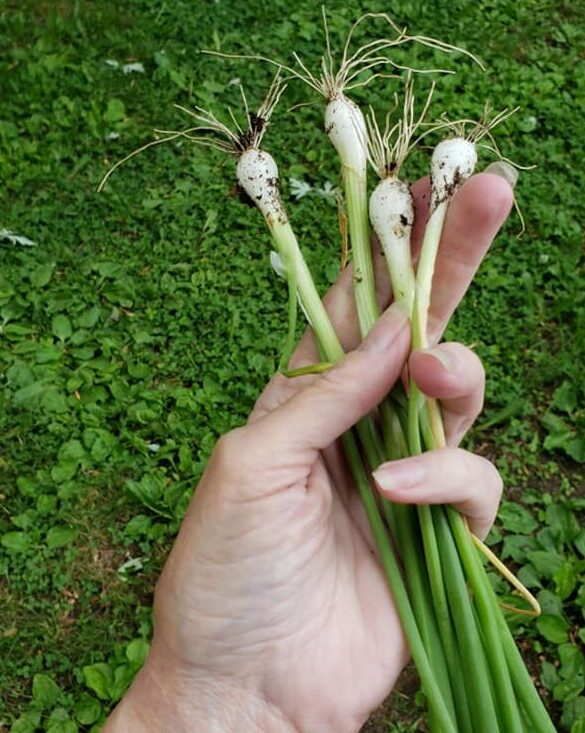Do you know that growing Bunching Onions in a container allows unrestricted subsurface root growth and moisture for the plantlets?
Learn how to grow Bunching Onions in containers and follow some tips to prolong their harvest.
Table of Contents Show
Can You Grow Bunching Onions in Containers?
Evergreen Bunching Onions, also called Green Onions or Scallions, are regular onions in their early growth stage with smaller bulbs.
You can grow the Bunching Onions in sizeable containers (plastic, clay, terracotta, or ceramic), where they multiply to form clumps.
Containers are ideal as Bunching Onions have thin fibrous roots that cannot spread to greater depths under the soil.

However, some additional favors you can gain from growing Bunching Onions in containers are as follows.
- The small area in the containers holds the nutrients aiding the short roots of onions to grab them.
- Estimating the amount of water and fertilizer is easy in small planters than in the open ground.
- Harvesting these perennials from a small container patch rather than the garden is painless.
- They form small underground bulbs. So, they rarely require vast belowground soil space.
Best Time to Grow Bunching Onions
Winter (December-January) is the accurate time to cultivate Bunching Onions for a lengthy harvest.

After planting Bunching Onion seeds in a pot or container, you can reap them in late spring to early summer (May-June) when the flowers fade to brown.
However, you can also plant the seeds in late summer to get garden-fresh Bunching Onions as fall or spring comes by.
This way, onions can have long-lasting foliar growth after transplanting them outdoors in spring (March).
How Long Do Bunching Onions Take to Grow?
Germination may initiate around 1-2 weeks on warm, well-draining soil saturated with moisture.

But, it may take 2-4 months to see well-yielding onion clumps in your garden.
To encourage regrowth, cut their leaves once they reach about 30 centimeters, and they will retain new foliage within 1-3 weeks.
Bunching Onions [Growth Requirements]
You can grow as many onion clumps as possible, but the containers must be spacious enough for the roots to roam freely under the soil.
Likewise, the substrate must blend the correct and appropriate amount of components.
1. Container for Bunching Onions
Several planter alternatives exist, like terracotta, plastic, and ceramic pots.
But, the containers for Bunching Onions must be around 6-12 inches deep with basal drainage holes and considerable width.
Check the table to know which containers you can use to grow Bunching Onions.
| Containers | Specifications |
|---|---|
| Caribbean Plastic Planters | Light weight with considerable brim width Drainage holes with detachable plug Dimensions: 8.25"×8.25"×6.75" |
| Terracotta Pots | Drainage holes with saucers at the base Lightweight but sturdy Dimensions: 6.5"×6.5"×6.5" |
| Sunnydaze Ceramic Pots | Strong and durable with glazed finish Frost-proof and with a drainage hole at the base Dimensions: 11.75"×6"×9.5" |
| Seed Starter Tray | Extra cup space for larger seedlings Comes with a humidity dome to preserve the humidity for germinating seeds Drainage hole present at the bottom of each cup |
| Flexible Plant Nursery Pots | Flexible pots with spacious depth for root growth Ample amount of drainage holes at the bottom Dimensions: 6.7"×5.1"×6.9" |
2. Soil for Bunching Onions
Use a well-draining, sandy, loamy, fluffy, organically rich, and water-retaining soil with low pH (5.5-7).

The soil must also be fluffy so the roots can willingly grow without hindrance.
Mix 1 part compost (cow dung), 2 parts normal garden soil, 3 parts sand, and 3 parts filler (decaying vegetables, coffee grounds, or coconut fiber).
Add water to mix it thoroughly so that the mixture stays evenly moist, and common household compost is also a good choice.
Check the table below for an idea about some commercial starter mix for the onions.
| Seed Starting Mixes | Specifications |
|---|---|
| Sun Gro Horticultural Seed Starter | Contains a mix of peat moss, perlite, dolomite lime, and organic agent |
| Espoma Organic Seed Starter Mix | Contains a supreme blend of peat moss, perlite, yucca extract, and lime Also has ecto and endo-mycorrhizae for root growth |
| Premier Horticulture Organic Pro Seed Starter | Contains coconut fiber for optimal root growth and rot protection Slow release of amended nutrients |
| Miracle-Gro Seed Starting Potting Mix | Easy to root cuttings from leaves, stems, and bulbs Easy to start the seedlings for most veggies |
| Purple Cow Organic Seed Starter | Rapid induction of germination Extra cow compost for faster germination |
How to Grow Bunching Onions in A Container?
You can grow Bunching Onions in containers using seeds or stem divisions.
Both methods are easy and reliable, ensuring fresh Green Onions every season.
1. Bunching Onions from Seeds
Seeds may be labeled as “scallion seeds” in your area.
Another choice is to harvest fresh seeds from the plants.
Collecting Bunching Onion Seeds
To collect the seeds, you can follow these steps.
- The flower heads turn brown and papery during late spring to early summer, with black, shield-shaped seeds.
- Using sterilized pruners, cut the flower heads from the base and separate the seeds from the husk.

Sowing Bunching Onion Seeds
Mid to late winter is the perfect time to sow Bunching Onion seeds.
It aids in the early establishment of the seedlings and hardens their roots during the transplanting process in spring.
You can follow these tips when the right time approaches to sow the seeds.
- Take containers or a 6-12 inches deep seed tray.
- Fill the pots or trays with the readymade potting soil or fill it with a common starter mix.
- Using chopsticks, dig up about 1/4th inch deep holes at 1 inch apart.

- You can plant about 3-5 seeds in each hole and cover lightly with soil.
- Moist the soil fairly with water and place the containers over a heating pad maintained at around 59-68°F.
- Cover the containers with plastic wrap to maintain a warm and humid environment.
- Locate the set-up near an east-facing window.
It will take the seeds about 1-2 weeks to germinate. Give them 4-6 hours of daily sunlight once the seedlings sprout.
After the seedlings sprout new leaves and become 3-4 inches tall, transplant them into the garden soil.
You can check the video below to revise the process of planting and growing Bunching Onions from seeds.
Planting Bunching Onions in Containers/ Ground
Bunching Onions requires transplanting to a bigger pot or warm ground to reduce the danger of root plugging.
They also require slightly wide legroom space for root growth to roam freely in the soil with each step.
You can begin transplanting when the ground temperature reaches around 59-68°F.
- Border a required garden patch using wooden planks and amend the area with the homemade mix to a foot depth.
- Prepare rows of soil about 9 inches apart using a gardening trowel.
- Gently uproot the seedlings from the containers and transplant them along the row length.

- Then, firm the soil around the onion roots to hold the seedlings in their place.
- The seedlings need to be 4-6 inches apart in each row.
- Apply a thick layer of mulch at the topsoil to suppress the weed growth around the seedlings.
- Water the seedlings when the soil is dry, and harvest after the foliage reaches about a foot long.
After this, the seedlings will focus their energy on showing rapid root development rather than using their energy for foliar growth.
2. Bunching Onions from Divisions
You can start a new Bunching Onion batch by planting onions from their divisions.
Here are the following steps for dividing and replanting your Bunching Onions.
- Choose the right time in spring or summer when the leaves are about a foot long.
- Uproot the clumps with your hand and separate the plants at the root ends.
- Replant it in the same manner as you do for the seedlings, ensuring a sufficient distance between the mature plants.

- Dividing and replanting will be easy if the seedlings are 3-4 inches tall, as the roots can easily regrow.
- Water the plants after the transplant to evenly moisten their roots.
- Also, apply some more mulch to cover the topsoil.
Harvesting Bunching Onions
Bunching Onions are used for soups, fried dishes, stews, etc., fresh after harvest.
When the leaves become slender, they arch and flop over the ground, indicating that the plants are ready to harvest.
Additionally, 3/4th of the plant leaves turn bright green with a darker hue at the leaf tips when the onion meets the harvesting period.

You can follow the steps below to ensure a successful harvest.
- Dig the onions from the bottom using a trowel and pull out the clump.
- After harvest, place the Onions in a tray and wash under the sink water to remove the attached soil.
- Finally, refrigerate the Onions or use them fresh on any dish you prepare.
Tips to Care for Bunching Onions
Bunching Onions may seem delicate, but they are hardy and drought-tolerant.
However, you can ensure a healthier harvest with minimal care from seedling to maturity.
- Use 0.016 liters of water for each plant in the clump. Follow-up watering by giving a “finger depth test.”
- Feed the plants with a high-nitrogen liquid fertilizer about 3 weeks after planting and continue the application once every 2-3 weeks until harvest.

- Mulch the topsoil in winter to warm the roots. Remove it once the ground warms become feasible in spring or summer.
- Invest in neem oil to deter pest or disease infestation and trim off yellow or brown foliage.
- Continue growing the Bunching Onions indoors under grow lights for 10-12 hours daily in winter.
From Editorial Team
Conclusion!
Bunching Onions in a container can easily grow throughout USDA zones 3-9, where the outdoor sunlight can directly furnish the plant.
Also, choose the right container with considerable depth and drainage holes that can retain moisture.


